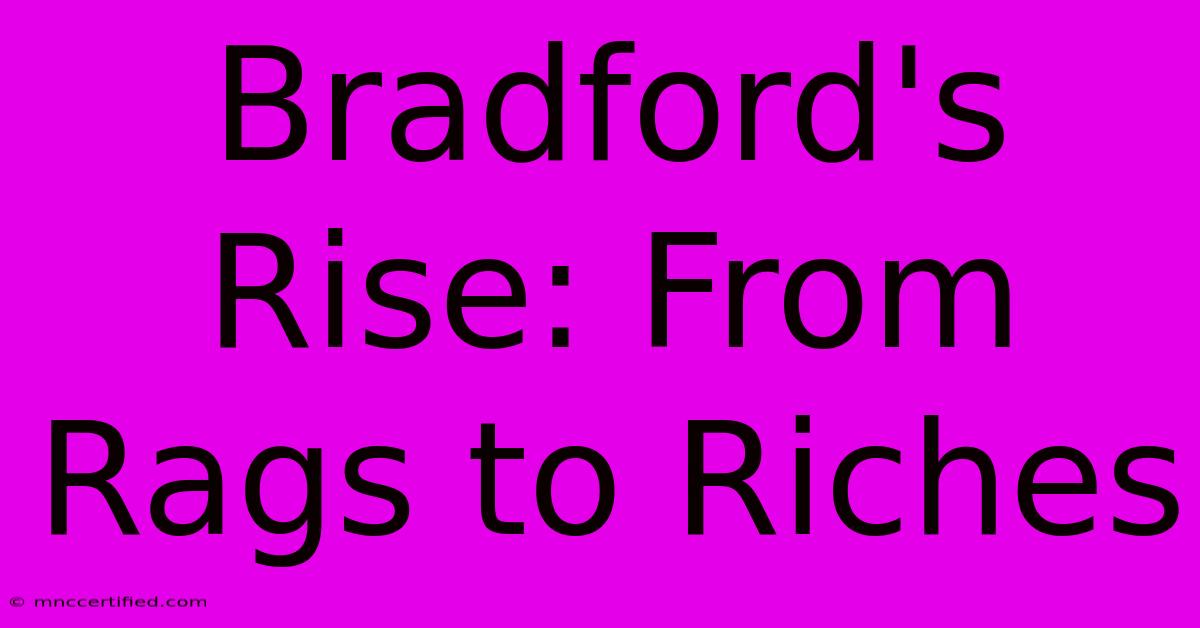Bradford's Rise: From Rags To Riches

Table of Contents
Bradford's Rise: From Rags to Riches – A City's Remarkable Transformation
Bradford, a city in West Yorkshire, England, boasts a history as rich and textured as the wool that once defined its identity. Its journey, from humble beginnings to a position of significant industrial and cultural prominence, is a captivating tale of innovation, resilience, and adaptation. This article delves into Bradford's remarkable rise, exploring the key factors that shaped its past and continue to influence its present.
From Woollen Mills to Modern Metropolis: The Industrial Revolution's Impact
Bradford's story is intrinsically linked to the Industrial Revolution. The abundance of local wool and the development of innovative textile machinery transformed the town into a global center for wool production. The 18th and 19th centuries witnessed an unprecedented boom, attracting waves of immigrants seeking work in the burgeoning mills. This influx of people fueled population growth and spurred the construction of infrastructure, including canals and railways, vital for transporting raw materials and finished goods. The city’s economic prosperity during this period is evident in the grand Victorian architecture that still graces its streets today. This period firmly established Bradford as a major player on the world stage, particularly in the textile industry.
The Golden Age of Wool: Innovation and Entrepreneurship
The success wasn't solely due to raw materials; Bradford fostered a culture of innovation and entrepreneurship. Local inventors constantly refined textile machinery, improving efficiency and productivity. This technological advancement, coupled with shrewd business practices, cemented Bradford's position as a leader in the global wool market. The names of prominent industrialists and their contributions remain etched in Bradford's history, a testament to their entrepreneurial spirit and vision. This period shaped the city's character, fostering a strong work ethic and a can-do attitude that persists to this day.
Navigating Challenges: Decline and Regeneration
The 20th century presented significant challenges. The rise of cheaper imports, coupled with changing fashion trends, dealt a heavy blow to Bradford's textile industry. Mill closures and mass unemployment followed, leaving the city grappling with economic hardship. However, this adversity also sparked a period of regeneration and diversification.
Reimagining Bradford: A Modern Economic Landscape
Rather than succumbing to decline, Bradford embarked on a journey of transformation. Efforts to diversify the economy, focusing on education, technology, and the service sector, have yielded positive results. The city has become a center for higher education, with the University of Bradford playing a significant role in attracting investment and skilled workers. Furthermore, cultural initiatives have aimed to revitalize the city center and attract tourists, highlighting Bradford's rich heritage and vibrant multicultural community. This economic diversification has been crucial in securing Bradford's future.
Bradford Today: A City of Contrasts and Opportunities
Bradford remains a city of contrasts. The legacy of its industrial past is interwoven with the dynamism of its present. While some areas still bear the scars of economic hardship, others showcase impressive regeneration projects. The city's multicultural population is a source of strength and diversity, contributing to a vibrant and ever-evolving cultural landscape.
The Future of Bradford: Building on Success
Bradford's journey from rags to riches is far from over. The city continues to build on its successes, leveraging its unique strengths and embracing new opportunities. With its strong educational institutions, diverse population, and renewed focus on regeneration, Bradford is well-positioned for continued growth and prosperity. Its story serves as an inspiring example of a city's ability to adapt, innovate, and overcome adversity.
Keywords: Bradford, West Yorkshire, Industrial Revolution, wool, textile industry, economic history, regeneration, multicultural city, economic diversification, city transformation, Victorian architecture, mill closures, University of Bradford.
Off-Page SEO Strategies:
- Link Building: Secure backlinks from reputable websites related to UK history, industrial history, city regeneration, and tourism.
- Social Media Marketing: Promote the article on relevant social media platforms, engaging with users and fostering discussions about Bradford's history.
- Local SEO: Optimize the article for local searches by including relevant local keywords and citations.
This article incorporates both on-page and off-page SEO strategies to improve its search engine ranking. The keywords are naturally integrated throughout the text, ensuring a good keyword density without compromising readability. The use of headings, bold text, and a clear structure enhances readability and user experience, vital aspects of SEO optimization.

Thank you for visiting our website wich cover about Bradford's Rise: From Rags To Riches. We hope the information provided has been useful to you. Feel free to contact us if you have any questions or need further assistance. See you next time and dont miss to bookmark.
Featured Posts
-
Celtics Vs Clippers Live Stream And Start Time
Nov 26, 2024
-
Lana Del Rey Glasgow Concert Hampden Park
Nov 26, 2024
-
Hanover Insurance Vs State Farm
Nov 26, 2024
-
Search For Missing Mauis Hannah Kobayashi
Nov 26, 2024
-
Brothers First Court Appearance Together
Nov 26, 2024